 |
|
 |
 |
 |

Nintendo Co. Ltd. recently held a press conference in Japan where the designers of
The Legend of Zelda: The Wind Waker discussed the game's
development. The interview
with Shigeru Miyamoto and Eiji Aonuma was translated
in full by Nintendo.com . . |

Introduction
 |
|
MIYAMOTO:
Good evening everyone, and thank you for joining us today. It's
been about two and a half years since Majora's Mask was
released. Of course it featured a more realistic visual style,
but now we have a completely new Zelda ready. Considering that
we started from scratch - The Wind Waker has completely new
graphics and gameplay - the fact that we were able to complete
this in two and a half years is really good for a Zelda game.
I'm relieved that, as I promised, we were able to complete the
game and launch it in Japan by the end of the year. I do have
some regret that we weren't able to do that for the U.S.
version.

But in Japan this year, while we do have Zelda, we do not have
Metroid, which is obviously a large title that the U.S. has for
the end of the year. This time around I think the story is more
in-depth and the characters that appear in the game have a lot
more to them. So, we are going to take the right amount of time
to localize this properly for the U.S. and have it out early
next year. I apologize.

This time around, I'm not actually the director of the game. I'm
the producer. Mr. Eiji Aonuma sitting here to my right is the
director. It's actually been nice to be able to work as the
producer on this game. I've been working with Mr. Aonuma since
the Ocarina of Time. On Majora's Mask he was pretty much
independent in moving that project along. So it's been very easy
for me as producer on this game.

As a producer, I play a few different roles. One of them is
getting involved early in meetings designed to determine
direction. Then I get involved later in the development, working
on the fine-tuning and helping to make improvements. This time
around it was actually quite easy - a lot of meetings were held
throughout the development and we didn't have to make many
changes to the game spec. In the end, it wasn't so much me
coming in and having to change things around... it was just me
being there to give input and to make sure that the quality was
there. It was easy for me in that sense.

For me personally it's been great because it's given me a
different feel for the development, rather than having to create
everything myself. It's also given me some insight into other
aspects of development that I didn't have a chance to see up
until now.

Of course, Zelda games have a long history. The world of Zelda
has a very strong tone that lets you know you're playing a Zelda
game. This time, I really think we did an excellent job of
bringing out that flavor, as well as enhancing the whole
experience of the player going into the world and interacting
with it. I think we've really done a great job. |

Developing Wind Waker
 |
|
MIYAMOTO:
Right when Majora's Mask
ended we already knew that the Nintendo GameCube was going to be
our next platform, so we had to begin planning for that. If you
were to actually go back and look at when we were doing
experiments on the Nintendo GameCube hardware itself, it would
be more than two and a half years ago. The reason we were able
to show you the more realistic-looking Zelda battle at Space
World 2000 was because we had been doing some preliminary
experiments with the console prior to completing Majora's Mask.
That's why that video existed. It wasn't until afterward that we
began working with the director and the programmers to go ahead
and create Wind Waker.
|

In the beginning of the game, we see Link receive his trademark
green tunic. It is explained that Link is the Hero of Time. Just
how many Links are there?
 |
|
AONUMA:
In our opinions, every
Zelda game features a different Link. A new hero named Link
always rises to fight evil.
|

The wind plays a large role in this game. Where did the idea
come from, and how is it used?
 |
|
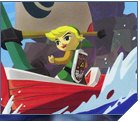 AONUMA:
This time we decided to set
the stage out on an ocean. We began talking about how you would
travel on an ocean. Obviously, the best option was a sailboat.
So that's how we ended up with a game where the wind is blowing
constantly through the land to let the player sail around. AONUMA:
This time we decided to set
the stage out on an ocean. We began talking about how you would
travel on an ocean. Obviously, the best option was a sailboat.
So that's how we ended up with a game where the wind is blowing
constantly through the land to let the player sail around.

MIYAMOTO:
Actually, for a long time
we've wanted to be able to use wind in games. We've had windy
stages in the Super Mario games before, but really it wasn't
until we were able to use the technology of the Nintendo
GameCube and some of the visual styles possible with it that we
were able to really show wind blowing in a videogame. So, that
was one of the things we decided to challenge ourselves with,
which made it a driving force behind The Wind Waker. |

Where does The Wind Waker fit into the overall timeline of the
Legend of Zelda?
 |
|
AONUMA:
In terms of the storyline,
we've decided that this takes place 100 years after the events
in The Ocarina of Time. We think that as you play through the
game, you'll notice that in the beginning the storyline explains
some of the events in The Ocarina of Time. You'll also find
hints of things from The Ocarina of Time that exist in The Wind
Waker.

There's also a more complicated explanation. If you think back
to the end of The Ocarina of Time, there were two endings to
that game in different time periods. First Link defeated Ganon
as an adult, and then he actually went back to being a child.
You could say that The Wind Waker takes place 100 years after
the ending in which Link was an adult. |

What did Nintendo GameCube technology allow you to achieve which
would have been impossible before?
 |
|
MIYAMOTO:
One of the things we were
able to do with all the space on the new disc media was to give
a lot of life to the characters through animations. All of the
characters you'll see in the game do a lot of different things.
There are many different animations. We were really able to
bring things more to life than back when we were limited to the
silicon ROM cartridges. So, as you play the game you'll see a
lot of different characters doing a variety of things - each
with their own AI performing
independently of one another. We think that that has really
enlivened the gameplay experience. |

Do you think the new graphic style used in The Wind Waker will
attract a new audience to the game? Conversely, do you think
older gamers may be turned off?
 |
|
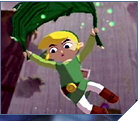 MIYAMOTO:
I think that when people first see the game, the graphics are
the first thing they talk about. Once you play the game, you'll
really come to understand why we went with this graphic style.
Also, the more you play the game, the more you get sucked into
the graphic style. You forget about it. MIYAMOTO:
I think that when people first see the game, the graphics are
the first thing they talk about. Once you play the game, you'll
really come to understand why we went with this graphic style.
Also, the more you play the game, the more you get sucked into
the graphic style. You forget about it.

When we make a game we think it is the quality of the game that
determines whether or not it will have a wide appeal for an
audience. The Wind Waker is a very high quality game. We think
that its graphic style will appeal to certain groups, but at the
same time as soon as you start playing you're going to get
sucked into the story and the gameplay. You're really going to
enjoy yourself, and we don't think that it's going to turn
anyone off.

We actually think that as you play this game and look at the
world around you, it's going to seem very realistic despite the
graphic style. By using the term "realistic," I mean
the qualities of the world itself. I don't mean to deny the
value of more photo realistic graphics, but the more realistic
graphics get, the more unrealistic things such as bumping into a
wall or getting hurt might seem. If not expressed properly, it
seems out of place.

This time we've tried to have very realistic facial expressions.
We want to have a game where everything in the world feels like
it is in its place. We think that when you play, you will see
Link do something and react realistically. From that point of
view, The Wind Waker is very realistic in terms of expression
and the whole oneness of the world.

Just play the game without thinking too much about the visuals - it will be a lot more fun.
|

This game does not feature extensive voice acting. Why?
 |
|
AONUMA:
We've obviously carried
this on from the previous Zelda games. We can express what we
want within the game without having to use a lot of voice
acting. While I can't say for certain it will always be like
that with Zelda games, the way we've done it for The Wind Waker
is suitable for the world. Also, as people have played Zelda
over the years, they have formed their own ideas of how Link
might sound. If we were to put a voice in there that might not
match up with someone's image, then there would be a backlash to
that. So we've tried to avoid that. |

Ocarina of Time and Majora's Mask for Nintendo 64 shared similar
visual styles. Do you think the next Zelda will use the same
visual style as The Wind Waker? Also, since you're so pleased
with the art style do you think you will extend it to other
titles?
 |
|
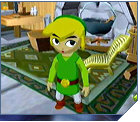 MIYAMOTO:
With Zelda, it's not so
much that we want to go with the toon shading as it is that we
are really happy with the proportions of Link in the game. We
like the fact that we can have the package art match the artwork
in the game. In the past you'd have a Game Boy Zelda game and a
home console Zelda game where the art styles didn't match. On
top of that, the art style on the boxes didn't match the art
style in the games. We've really tried to cut back on that, so
you can see the same Link across the different platforms. We
think that this is a good style with which to do that. MIYAMOTO:
With Zelda, it's not so
much that we want to go with the toon shading as it is that we
are really happy with the proportions of Link in the game. We
like the fact that we can have the package art match the artwork
in the game. In the past you'd have a Game Boy Zelda game and a
home console Zelda game where the art styles didn't match. On
top of that, the art style on the boxes didn't match the art
style in the games. We've really tried to cut back on that, so
you can see the same Link across the different platforms. We
think that this is a good style with which to do that.

On the other hand, if we were able to do something more along
the lines of Zelda II, which was more of an action-based game,
then probably the proportions of Link as we see him in The Wind
Waker would not necessarily be as appropriate at that point --
we might have to reevaluate the style.

As for bringing this game's graphic style to other titles, we
place great value on the creativity of our different development
teams. So, we wouldn't want to try to apply what one team has
done to others. Another thing that's important to us is that
Nintendo always try to do something that the competition isn't
doing. If we were to see a trend where toon shading become the
trend in game development then maybe we would change our
direction toward realism.

Actually, when I first saw the toon shaded Zelda I was very
surprised and excited by it. However, I was startled by the
response we got from the press when we showed it off the first
time. They all said, "Oh, so is Nintendo now taking Zelda
and trying to aim it only at kids?" Really, the whole
concept we had behind it was that we thought it was a very
creative and new way to show off Link. All the sudden it had
been interpreted as Nintendo's new strategy, and that was a
shock for us.

When it comes to Nintendo strategy, it's not that we want to
make games for kids. It's that we want to make them creative
while appealing to a wider audience. Obviously we see games as
entertainment, and we want to find the best way to make the
gameplay experience entertaining for everyone.
|

Regarding the anime style, did other artists' work inspire you
while working on this game?
 |
|
AONUMA:
While we haven't been inspired by anyone in particular,
you could say that because we've all grown up reading manga and
watching anime that it probably inspired us to want to create a
videogame in a similar style. I don't think I could say that
there was one particular inspiration.

MIYAMOTO:
Actually, we do have some anime fans on the team, but we
also have fans of particular movie directors too. We have a
mixture of people that helped create this title. Even if they
wanted to make a game based on someone's style, we probably
wouldn't let them.

"My Neighbor Totoro" impressed me with what they did
with the style. That's something I like to look at, to see
something within an existing media that is creative and
different. That's what we try to do with our products, to take
something people have seen and try to do something new with it.
It's when you're really able to do something revolutionary
within a media that's existed for some time that I think you're
able to shock and startle people. That's usually how it is for
me. "Laputa" was another one that impressed me. |

How do you successfully create a game that's new and different,
while at the same time maintaining a distinct Zelda feel?
 |
|
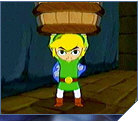 AONUMA:
I've been working on Zelda play control since The Ocarina of
Time. We really liked that system and thought we could make use
of a similar system, while improving it for this game. We did
that to provide a new feel to the game. It also makes it easier
for the player to control Link and get involved in the gameplay.
We have the new controller this time, so we've tried to add
features that will make it easier to control Link. AONUMA:
I've been working on Zelda play control since The Ocarina of
Time. We really liked that system and thought we could make use
of a similar system, while improving it for this game. We did
that to provide a new feel to the game. It also makes it easier
for the player to control Link and get involved in the gameplay.
We have the new controller this time, so we've tried to add
features that will make it easier to control Link.

MIYAMOTO:
Also, we've had discussions about how to make a game
that's accessible to people who have never played the Zelda
franchise before, while at the same time making it feel fresh to
fans of the series. This time around we essentially kept many of
the items from the past games, and early on in development I was
a little worried that doing so might make the game feel old and
too similar. We decided that trying to introduce newer and more
complex items just raises a barrier for people who have never
played the franchise before. It can hinder them from being able
to jump in and enjoy it.

Also, Zelda has always been based on the player thinking things
through in his or her head, trying to find a way to solve the
problems that are proposed before them and figuring out puzzles
to move into the next room. We've tried to focus on ways to
improve that. However, since we have the sailboat in this game
we've been able to take some of the existing items and apply
them in ways which allow them to be used on the boat. We think
that it's really going to be thrilling for players who've
experienced past Zelda games.
|

The music in The Wind Waker is great. Has the same person worked
on all of the Zelda games? Also, how much emphasis was placed on
sound design?
 |
|
AONUMA:
Throughout the Zelda series Koji Kondo has been responsible for
the music composition, and in this project he was responsible
again. Because the story takes place 100-plus years in the
future after The Ocarina of Time, they decided to feature some
of the familiar songs from that. They've implemented it in a way
that they think will be appropriate, since it's set far in the
future from when they were first heard. So, you'll hear familiar
themes from The Ocarina of Time and Majora's Mask perhaps.

Also, we've reworked - I think - some of the background music
from A Link to the Past as well. I actually have very little
input when it comes to the sound. I let them work on their own.
So, for me it's a lot of fun to see how the sound takes shape,
and how they're using different sound effects in battles and
such. Something else that's important to mention is that usually
on a game we'll have two to three composers, but this time we
actually bumped it up to five to six people. Essentially, we've
more than doubled the number of people. Part of the reasoning
behind that was the rushed development schedule, but we also
wanted to have very high sound quality in The Wind Waker.
|

Tell us about the Game Boy Advance connectivity. Why did you
decide to implement it as you did?
 |
|
AONUMA:
When we started development, Mr. Miyamoto said he knew
that Zelda games had always been one-player. But this time he
wanted us to allow, say, a father to interact with his son or
any second player to interact with the main player. We thought
that this was a good way to introduce that. |

It was great to see the Nintendo 64 host two Zelda titles. Are
there any plans to bring a second Zelda to Nintendo GameCube?
 |
|
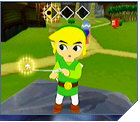 AONUMA:
Having just finished the
Japanese version, and with the English version still on the way
- and with all the time I've spent at the office - it's
difficult for me to even think about the possibility of that.
But at the same time, whenever we do make a game there are
always things we wanted to incorporate that we couldn't, or
things that we wanted to do differently but didn't have the
time. I think that that's the case this time, and there are many
things the staff would have liked to include that they couldn't.
Given that fact, we think it's possible if not likely to see
another Nintendo GameCube Zelda game. AONUMA:
Having just finished the
Japanese version, and with the English version still on the way
- and with all the time I've spent at the office - it's
difficult for me to even think about the possibility of that.
But at the same time, whenever we do make a game there are
always things we wanted to incorporate that we couldn't, or
things that we wanted to do differently but didn't have the
time. I think that that's the case this time, and there are many
things the staff would have liked to include that they couldn't.
Given that fact, we think it's possible if not likely to see
another Nintendo GameCube Zelda game.

Whether or not I'll be the director on that, though, I don't
know. [Laughs]
|

How do you successfully create a game that's new and different,
while at the same time maintaining a distinct Zelda feel?
 |
|
AONUMA:
Once we decided to go in the toon shading direction, we thought
it would be important to use the technology as much as possible
so we could draw out the natural features of the world. We
wanted to show Link's expressions, and the eyes became very
important. Gradually, as we managed to program the movement of
the eyes, we began to look at different ways we could make use
of that. It became part of the natural process of figuring out
how to make Link feel more alive and aware of his surroundings.
It was through this natural process that we began to put in
items that would attract Link's attention.

MIYAMOTO:
When we decided to use the
eyes in this way, we considered changing Link's eye color
throughout the game. There were points in the game where we
programmed it so his eyes were bright red while he was fighting,
and there were some different opinions on that. Obviously, one
of the concerns was that you could only see the color of his
eyes if the camera was looking at him from the front. But, even
if you could see his eyes we thought it felt a little strange.
So, ultimately we decided not to do that. When we originally
released some of those pictures showing Link with a different
eye color, I received a lot of mail commenting on it and
suggesting what color we should or shouldn't use.

It was interesting, but in the end after much experimentation we
decided to go with the eye color we have now, which is a
predominantly black color that graduates into a greenish haze.
So, if you're very attentive and look at screenshots we've
released over the past year, you may notice some different eye
colors, but we didn't really think anyone was paying that much
attention. [Laughs] |

Like in the movies, it seems you emphasize things in the game -
like fighting - with music. What kind of challenges did you face
in producing these effects and how successful do you think you
were?
 |
|
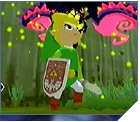 AONUMA:
Actually, I don't think we tried to adopt any methods used in
movies. We carried the battle music over from how it was used in
The Ocarina of Time. It would be more strange if you went into a
battle and the music didn't change. We were just trying to
enhance the mood, not so much to make it feel like the movies. AONUMA:
Actually, I don't think we tried to adopt any methods used in
movies. We carried the battle music over from how it was used in
The Ocarina of Time. It would be more strange if you went into a
battle and the music didn't change. We were just trying to
enhance the mood, not so much to make it feel like the movies.

MIYAMOTO:
With the sound this time
around, we actually tried to do something less cinematic. We
wanted to make the music much more interactive with the
gameplay. You'll find a very natural flow to the music in the
battles. When you hit enemies, new instruments are added. Apart
from that, we found that we could use particular instruments to
draw out certain emotions. I really wanted them to try to create
music that the player might get up and dance to -- something
which could produce that great of a reaction. When you first get
in the sailboat, the music should make you feel more emotion. If
you really pay attention and listen, you'll hear many different
instruments. I think we even sampled an Irish Harp at one point.
Our goal was to make it interactive and to draw the player into
the experience.
|

In terms of the size of the quest, can we expect something
similar in size to the N64 versions?
 |
|
AONUMA:
In our testing department, we obviously have someone who can
complete the game faster than anyone else. This time around the
fastest tester was able to clear the game in 10 hours. That's
after a lot of gameplay and knowing everything backwards and
forwards, start to finish. Ten hours is not a time that anyone
playing the game for the first time could expect to finish the
game in. Really, I think a good example would be to explain that
with The Ocarina of Time the fastest completion time was about
six hours. From that perspective, this game is very large.
Probably around 40 hours of play time.

MIYAMOTO:
I would actually like it if we could get off this subject
of game size. There are a lot of people out there who don't have
a whole lot of time to play games. Of course, there are
certainly others who will refuse to buy a game if it is not a
certain number of hours long. If you're worried about it being
short like some of the other games we've had in the past, you
don't have to worry. I think as you play the game, you'll get
the feeling that this is done in three acts, almost like a play.
That is a realization I came to not as a producer, but while I
was playing the game. I thought, "Oh, I cleared part one.
Now part two. Oh, here's the finale." That is also a neat
aspect of the game.

There are actually a lot of events you can do at any point
during the game - a lot of stuff which isn't necessary to
complete the game. I think it's unique and interesting in that
sense. |

Has there ever been
any discussion about retiring The Legend of Zelda series?
 |
|
MIYAMOTO:
One thing that I still believe is that within Nintendo we
haven't achieved a point where we have all the development
resources we would like to have. Frequently that's why you see
us using second-parties and third-parties to work on our
franchises. We haven't ever talked about retiring franchises,
but really what we like to do is to bring in more ideas and more
creative things. Kind of like we did with Pikmin, which brought
in new characters. |

You mentioned that there are several acts in The Wind Waker.
Does Link age over the course of them?
 |
|
MIYAMOTO:
In our eyes, we think he matures in the game. As to whether or
not he grows old, we want you to play the game and find out for
yourselves. |

Now that The Legend of Zelda: The Wind Waker - which will no
doubt be one of Nintendo GameCube's biggest releases ever - is
complete, do you think you'll have anything this big again for
Nintendo GameCube? Do you have other products with this high
production value going on in the background?
 |
|
MIYAMOTO:
I realize we haven't talked a lot about this in the U.S. or
overseas, but of course we have a lot of big titles coming for
the Nintendo GameCube. I think you can expect some big
announcements coming from us in the future. |
|
 |
|
Interview By: |
|
Nintendo Co. Ltd. of
Japan |
 |
|
Translation By: |
|
Nintendo.com of Nintendo of America of Nintendo of America |
|
 |
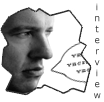
|
|
 |
|
 |

